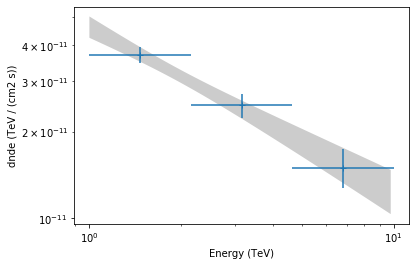This is a fixed-text formatted version of a Jupyter notebook
You can contribute with your own notebooks in this GitHub repository.
Source files: analysis_2.ipynb | analysis_2.py
Second analysis¶
This notebook shows the same Crab analysis as performed in the analysis_1 notebook but this time without the high level interface provided by the Analysis class. DL3 data release 1.
As before, we will reduce the data to cube datasets and perform a simple 3D model fitting of the Crab nebula.
The tutorial follows a typical analysis:
Observation selection
Data reduction
Model fitting
Estimating flux points
but it gives more details on lower level API.
First, we setup the analysis by performing required imports.
[1]:
%matplotlib inline
import matplotlib.pyplot as plt
[2]:
from pathlib import Path
import numpy as np
from astropy import units as u
from astropy.coordinates import SkyCoord
from regions import CircleSkyRegion
[3]:
from gammapy.data import DataStore
from gammapy.maps import WcsGeom, MapAxis
from gammapy.cube import MapDatasetMaker, MapDataset, SafeMaskMaker
from gammapy.modeling.models import (
SkyModel,
PowerLawSpectralModel,
PointSpatialModel,
)
from gammapy.modeling import Fit
from gammapy.spectrum import FluxPointsEstimator
Defining the datastore and selecting observations¶
We first use the gammapy.data.DataStore object to access the observations we want to analyse. Here the H.E.S.S. DL3 DR1.
[4]:
data_store = DataStore.from_dir("$GAMMAPY_DATA/hess-dl3-dr1")
We can now define an observation filter to select only the relevant observations. Here we use a cone search which we define with a python dict.
We then filter the ObservationTable with gammapy.data.ObservationTable.select_observations().
[5]:
selection = dict(
type="sky_circle",
frame="icrs",
lon="83.633 deg",
lat="22.014 deg",
radius="5 deg",
)
selected_obs_table = data_store.obs_table.select_observations(selection)
We can now retrieve the relevant observations by passing their obs_id to thegammapy.data.DataStore.get_observations() method.
[6]:
observations = data_store.get_observations(selected_obs_table["OBS_ID"])
Preparing reduced datasets geometry¶
Now we define a reference geometry for our analysis, We choose a WCS based geometry with a binsize of 0.02 deg and also define an energy axis:
[7]:
energy_axis = MapAxis.from_edges(
np.logspace(0.0, 1.0, 4), unit="TeV", name="energy", interp="log"
)
geom = WcsGeom.create(
skydir=(83.633, 22.014),
binsz=0.02,
width=(2, 2),
coordsys="CEL",
proj="CAR",
axes=[energy_axis],
)
# Reduced IRFs are defined in true energy (i.e. not measured energy).
energy_axis_true = MapAxis.from_edges(
np.logspace(-0.3, 1.3, 10), unit="TeV", name="energy", interp="log"
)
Now we can define the target dataset with this geometry.
[8]:
stacked = MapDataset.create(
geom=geom, energy_axis_true=energy_axis_true, name="crab-stacked"
)
Data reduction¶
Create the maker classes to be used¶
The gammapy.cube.MapDatasetMaker object is initialized as well as the gammapy.cube.SafeMaskMaker that carries here a maximum offset selection.
[9]:
offset_max = 2.5 * u.deg
maker = MapDatasetMaker()
maker_safe_mask = SafeMaskMaker(methods=["offset-max"], offset_max=offset_max)
Perform the data reduction loop¶
[10]:
%%time
for obs in observations:
# First a cutout of the target map is produced
cutout = stacked.cutout(obs.pointing_radec, width=2 * offset_max)
# A MapDataset is filled in this cutout geometry
dataset = maker.run(cutout, obs)
# The data quality cut is applied
dataset = maker_safe_mask.run(dataset, obs)
# The resulting dataset cutout is stacked onto the final one
stacked.stack(dataset)
CPU times: user 1.69 s, sys: 108 ms, total: 1.8 s
Wall time: 1.86 s
Inspect the reduced dataset¶
[11]:
stacked.counts.sum_over_axes().smooth(0.05 * u.deg).plot(
stretch="sqrt", add_cbar=True
)
[11]:
(<Figure size 432x288 with 2 Axes>,
<matplotlib.axes._subplots.WCSAxesSubplot at 0x118907898>,
<matplotlib.colorbar.Colorbar at 0x118b00438>)
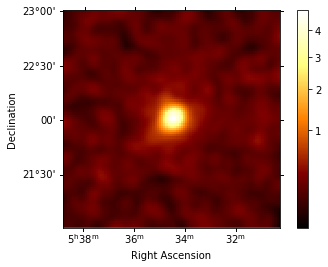
Save dataset to disk¶
It is common to run the preparation step independent of the likelihood fit, because often the preparation of maps, PSF and energy dispersion is slow if you have a lot of data. We first create a folder:
[12]:
path = Path("analysis_2")
path.mkdir(exist_ok=True)
And then write the maps and IRFs to disk by calling the dedicated gammapy.cube.MapDataset.write() method:
[13]:
filename = path / "crab-stacked-dataset.fits.gz"
stacked.write(filename, overwrite=True)
Define the model¶
We first define the model, a SkyModel, as the combination of a point source SpatialModel with a powerlaw SpectralModel:
[14]:
target_position = SkyCoord(ra=83.63308, dec=22.01450, unit="deg")
spatial_model = PointSpatialModel(
lon_0=target_position.ra, lat_0=target_position.dec, frame="icrs"
)
spectral_model = PowerLawSpectralModel(
index=2.702,
amplitude=4.712e-11 * u.Unit("1 / (cm2 s TeV)"),
reference=1 * u.TeV,
)
sky_model = SkyModel(
spatial_model=spatial_model, spectral_model=spectral_model, name="crab"
)
Now we assign this model to our reduced dataset:
[15]:
stacked.models = sky_model
Fit the model¶
The gammapy.modeling.Fit class is orchestrating the fit, connecting the stats method of the dataset to the minimizer. By default, it uses iminuit.
Its contructor takes a list of dataset as argument.
[16]:
%%time
fit = Fit([stacked])
result = fit.run(optimize_opts={"print_level": 1})
------------------------------------------------------------------
| FCN = 1.485E+04 | Ncalls=129 (129 total) |
| EDM = 2.43E-07 (Goal: 1E-05) | up = 1.0 |
------------------------------------------------------------------
| Valid Min. | Valid Param. | Above EDM | Reached call limit |
------------------------------------------------------------------
| True | True | False | False |
------------------------------------------------------------------
| Hesse failed | Has cov. | Accurate | Pos. def. | Forced |
------------------------------------------------------------------
| False | True | True | True | False |
------------------------------------------------------------------
CPU times: user 2.98 s, sys: 152 ms, total: 3.13 s
Wall time: 3.42 s
The FitResult contains information on the fitted parameters.
[17]:
result.parameters.to_table()
[17]:
| name | value | error | unit | min | max | frozen |
|---|---|---|---|---|---|---|
| str9 | float64 | float64 | str14 | float64 | float64 | bool |
| lon_0 | 8.362e+01 | 3.127e-03 | deg | nan | nan | False |
| lat_0 | 2.202e+01 | 2.764e-03 | deg | -9.000e+01 | 9.000e+01 | False |
| index | 2.575e+00 | 1.036e-01 | nan | nan | False | |
| amplitude | 4.644e-11 | 3.971e-12 | cm-2 s-1 TeV-1 | nan | nan | False |
| reference | 1.000e+00 | 0.000e+00 | TeV | nan | nan | True |
| norm | 9.555e-01 | 2.242e-02 | 0.000e+00 | nan | False | |
| tilt | 0.000e+00 | 0.000e+00 | nan | nan | True | |
| reference | 1.000e+00 | 0.000e+00 | TeV | nan | nan | True |
Inspecting residuals¶
For any fit it is usefull to inspect the residual images. We have a few option on the dataset object to handle this. First we can use .plot_residuals() to plot a residual image, summed over all energies:
[18]:
stacked.plot_residuals(method="diff/sqrt(model)", vmin=-0.5, vmax=0.5)
[18]:
(<matplotlib.axes._subplots.WCSAxesSubplot at 0x118eadf60>, None)
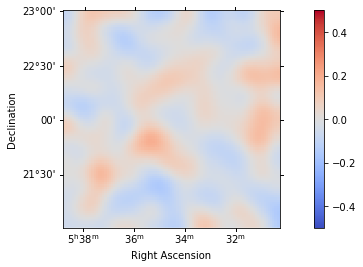
In addition we can aslo specify a region in the map to show the spectral residuals:
[19]:
region = CircleSkyRegion(
center=SkyCoord("83.63 deg", "22.14 deg"), radius=0.5 * u.deg
)
[20]:
stacked.plot_residuals(
region=region, method="diff/sqrt(model)", vmin=-0.5, vmax=0.5
)
[20]:
(<matplotlib.axes._subplots.WCSAxesSubplot at 0x1193da1d0>,
<matplotlib.axes._subplots.AxesSubplot at 0x1195c8390>)
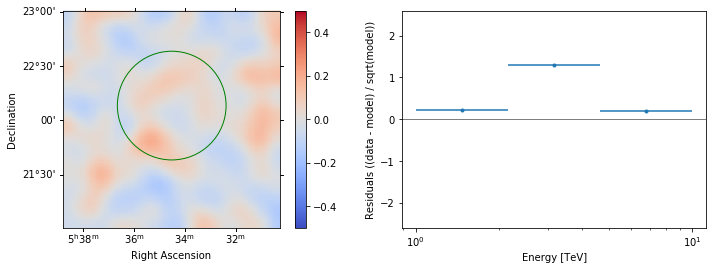
We can also directly access the .residuals() to get a map, that we can plot interactively:
[21]:
residuals = stacked.residuals(method="diff")
residuals.smooth("0.08 deg").plot_interactive(
cmap="coolwarm", vmin=-0.1, vmax=0.1, stretch="linear", add_cbar=True
)
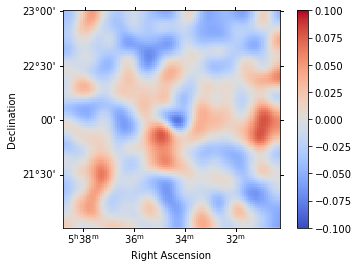
Inspecting fit statistic profiles¶
To check the quality of the fit it is also useful to plot fit statistic profiles for specific parameters. For this we use gammapy.modeling.Fit.stat_profile().
[22]:
profile = fit.stat_profile(parameter="lon_0")
For a good fit and error estimate the profile should be parabolic, if we plot it:
[23]:
total_stat = result.total_stat
plt.plot(profile["values"], profile["stat"] - total_stat)
plt.xlabel("Lon (deg)")
plt.ylabel("Delta TS")
[23]:
Text(0, 0.5, 'Delta TS')
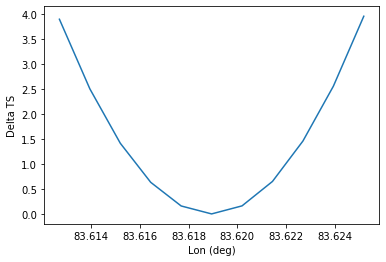
Plot the fitted spectrum¶
Making a butterfly plot¶
The SpectralModel component can be used to produce a, so-called, butterfly plot showing the enveloppe of the model taking into account parameter uncertainties.
To do so, we have to copy the part of the covariance matrix stored on the FitResult on the model parameters:
[24]:
spec = sky_model.spectral_model
# set covariance on the spectral model
covar = result.parameters.get_subcovariance(spec.parameters)
spec.parameters.covariance = covar
Now we can actually do the plot using the plot_error method:
[25]:
energy_range = [1, 10] * u.TeV
spec.plot(energy_range=energy_range, energy_power=2)
ax = spec.plot_error(energy_range=energy_range, energy_power=2)
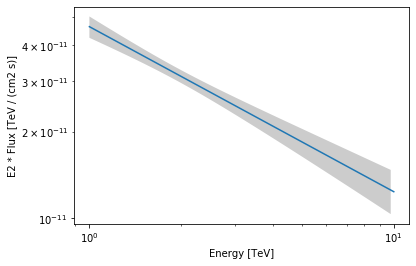
Computing flux points¶
We can now compute some flux points using the gammapy.spectrum.FluxPointsEstimator.
Besides the list of datasets to use, we must provide it the energy intervals on which to compute flux points as well as the model component name.
[26]:
e_edges = [1, 2, 4, 10] * u.TeV
fpe = FluxPointsEstimator(datasets=[stacked], e_edges=e_edges, source="crab")
[27]:
%%time
flux_points = fpe.run()
CPU times: user 1.93 s, sys: 50.2 ms, total: 1.98 s
Wall time: 2.17 s
[28]:
ax = spec.plot_error(energy_range=energy_range, energy_power=2)
flux_points.plot(ax=ax, energy_power=2)
[28]:
<matplotlib.axes._subplots.AxesSubplot at 0x11a0acf60>
